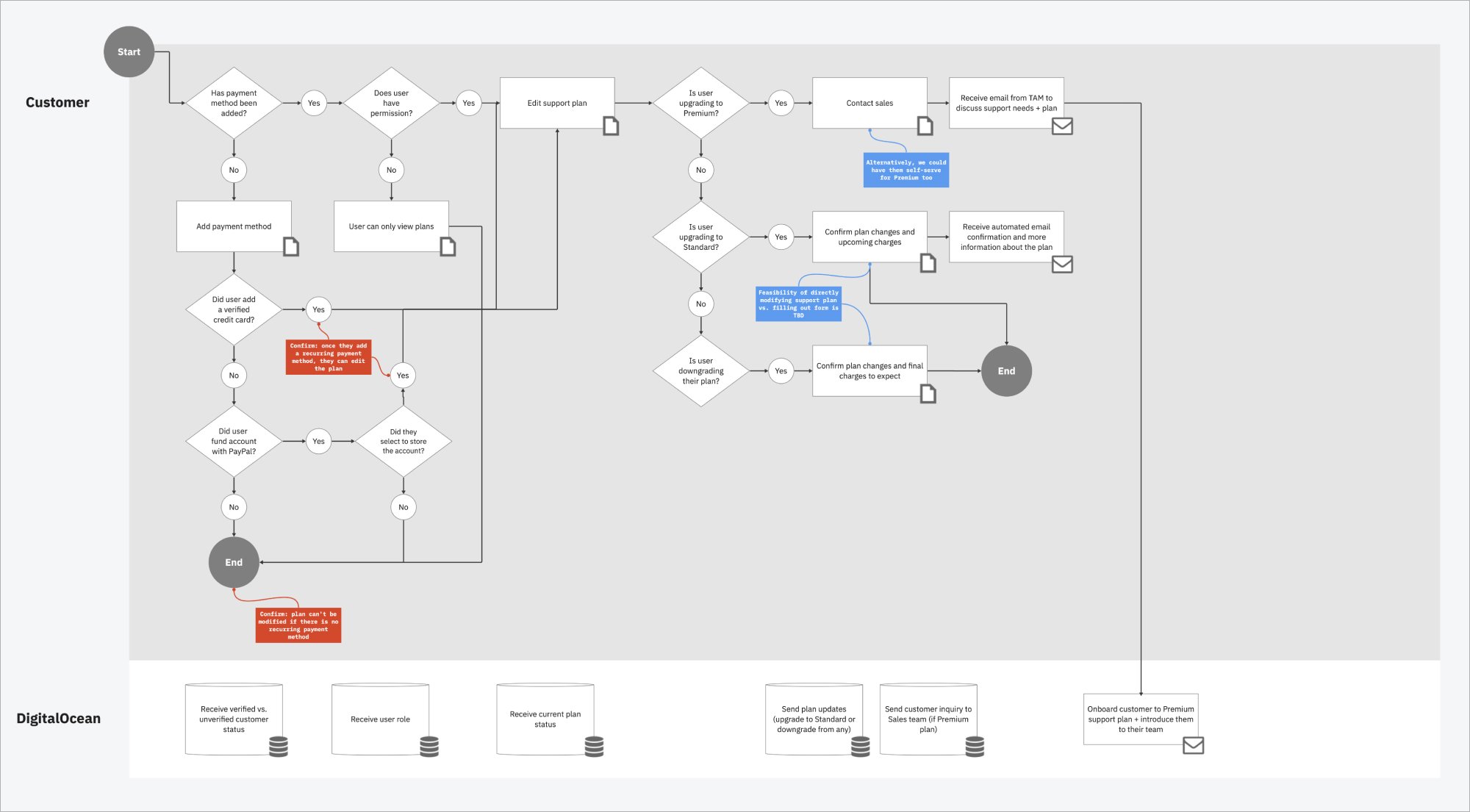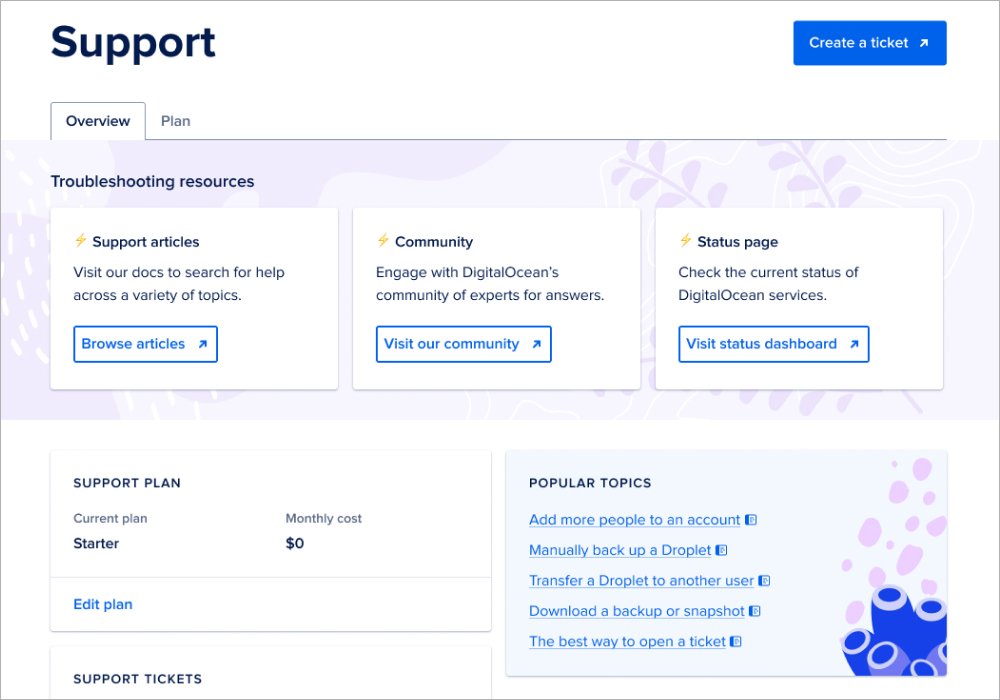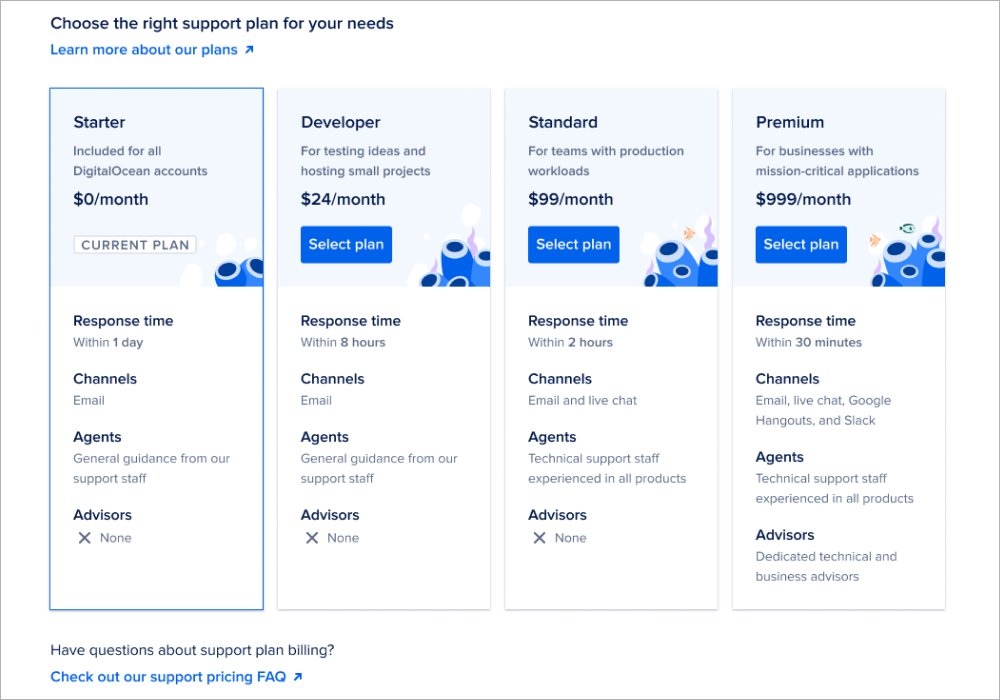Product Design
DigitalOcean Support
Customized support plans for businesses with mission-critical infrastructure and applications.
Role: I led product design and UX writing. I collaborated with a product manager, UI engineer, researcher, and our support team.
Opportunity
Customers expected diverse support options from a cloud platform meant to serve small to medium-sized companies. We weren’t evolving to meet these needs, which impacted our ability to acquire and retain businesses.
The company experienced a major shift in priorities to ensure focus on business users. I was reassigned to a high-priority effort focused on launching new paid support plans and they were expected to be released in less than one month. To ramp up, I interviewed stakeholders and evaluated our current experience to understand the project’s needs. Through that initial discovery, I learned four key findings:
We already had a premium support plan, but it wasn’t advertised and its pricing model was inconsistent. It was used primarily as a negotiation tool to onboard business customers and had ill-defined response time commitments.
A pilot of paid support plans was recently launched, but the sign-up process was very manual for customers and our internal teams. It spanned a marketing page, a Marketo form, the support portal, Jira, Slack, and our internal customer database. Nothing was automated and our systems weren’t talking to each other.
Users filled out the form to escalate their current support issue, not sign up for a paid support plan.
The benefits of each plan didn’t offer much differentiation. There wasn’t a good enough reason for users to upgrade their support plan unless they specifically needed a customer success or technical account manager.
-

A fragmented experience stitched together with Jira tickets
User research + project planning
Our timeline was tight so I worked with my team on creating a phased and iterative approach to releasing this new experience.
The first phase of work focused on launching a self-service support plan selection experience to automate manual processes. Future phases focused on simplifying downgrades and plan change policies. I worked with stakeholders on defining unknowns to help formalize research objectives. Our researcher conducted interviews to understand our customers’ expectations for paid support plans so we could evolve their benefits.
Outcome
We defined new support plan benefits, streamlined the flow, and got our systems talking to one another.
I created system maps and user flows to align the team around how to handle plan changes and access control internally. I also encouraged us to consider the support experience beyond plan selection. Our control panel and support portal were siloed. There was a disconnect between where users select a support plan and where they receive support so I designed an experience that facilitated a connection between the two.
-

Flow of data and access control
-

Troubleshooting resources
I created a new support section in the control panel to bridge the gap between the support ticket management, docs, and plan selection experience.
-

Support plans
I designed how a user compares and selects support plans. User research informed what specific plan benefits were necessary to highlight.
-

Self-service plan changes
A multi-step cross-touchpoint process was simplified into one step. Entry points to contact sales were included for higher-tier plans.
-

Scheduled communications
I defined how we communicate immediate and scheduled plan changes to users. I also mapped which team members receive communications.
Key results
We deprecated user-facing and internal manual processes in favor of automating plan changes.
We iteratively released five phases of work in one quarter to meet business goals.
Support plan upgrades increased by 36% in the first two months of releasing the self-service experience.
Continued improvements
After the phases were released, the team continued to experiment, research, and identify new opportunities.
Support plan benefits have since been added and pricing was adjusted to improve adoption. Further expanding benefits and better integrating the support ticket management experience is on the horizon. Integrating Salesforce and our control panel is no small feat so we created a phased project plan to help kick off that work. We also acquired new companies and their support plans will eventually need to map to ours as we integrate their products into our ecosystem.
If you are interested in learning more about this work, reach out, and let’s chat.